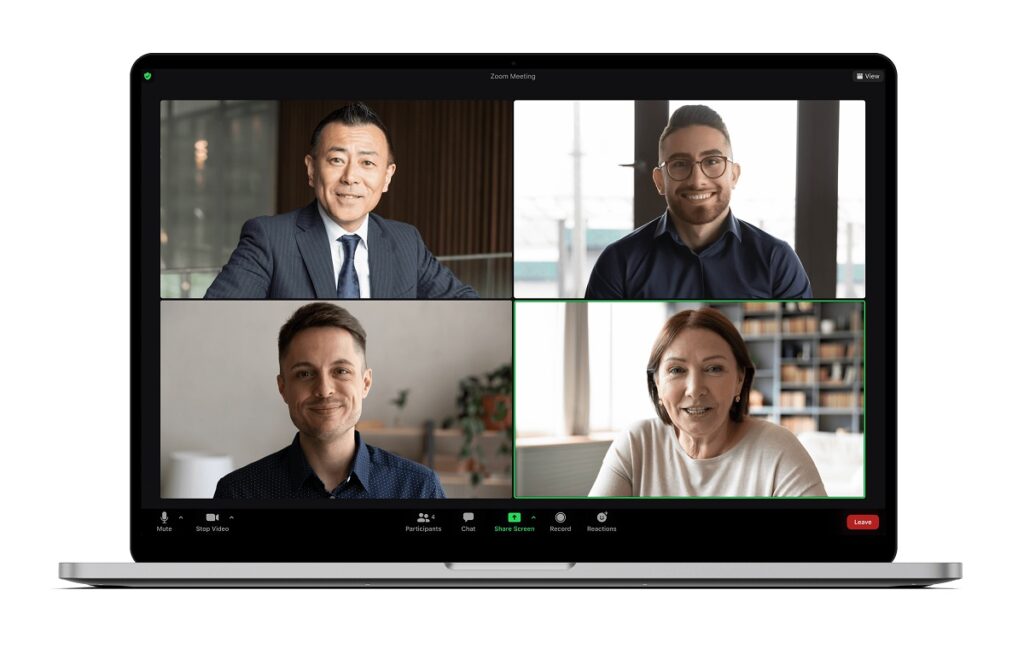
Two years ago, very few people had ever heard of Zoom. At the time, video conferences were rare and remote work was an exceptional circumstance. Now, the video platform has become so entrenched in our daily lives that its name has turned into a verb.
During the long months of lockdown, Zoom calls allowed people to work, study and socialise, from a distance. The company, virtually unknown in the mainstream, grew exponentially in the span of a few months. While three million people participated in a Zoom meeting during the whole of 2013, by March 2020 this number soared to 200 million a day. The following month, the company had increased its revenue by 169% and “zooming” had become the word on everyone’s lips.
From the other side of a Zoom call, of course, Darren Pattie, Head of Zoom Phone for EMEA, speaks to Digital Bulletin about the company’s astonishing rise, and its next steps as the world moves into the era of hybrid work.
“It’s been an extraordinary two years,” he says. “We’ve seen circumstances, which I hope are once-in-a-lifetime events. But, from a Zoom point of view, we’ve been very humbled and privileged to be able to provide a solution which enables people to connect with loved ones, family and friends and helped businesses to survive or thrive.
“We’ve helped educators to teach, we’ve helped doctors to care and we’ve helped governments to govern. And the fact that we were running 300 million meetings globally per day during the height of the pandemic just shows you how much value we were able to bring.”

Its impact is obvious. In only a few months, phrases like “I’ll zoom you later” or “zoom school” have made the company’s name a verb as common as “googling” or “photoshopping”.
Pattie recognises that the pandemic has not only helped grow Zoom’s business but it also had “a significant impact” in the company’s brand awareness. That raises the obvious question: How did a brand that was so little known rise above tech giants of the likes of Google and Microsoft?
Despite having similar products, Google and Microsoft’s video-meeting platforms fell millions short of Zoom’s number of daily users during the lockdown and, although successful, they have never been unable to catch up to its success. In Pattie’s view, the key to the mystery is simple: Zoom listens to what customers want and develops products that meet those demands.
“We can deliver new widgets and new functionalities to market really quickly, and we do that because we listen to what’s important to our customers,” he says. “If you understand what’s important to them and why, you can then help them solve problems quicker, or you can help them address their customers in a better way or be more competitive. And that’s part of the reason why we’re different, because we’re not slowed down by a legacy technology debt, which many of the competitors in the marketplace are. We dealt with the most difficult thing first.”
Live video is a very technically difficult product to provide, not only because of the huge amounts of storage space, network bandwidth, efficient algorithms, and resilience that it requires, but also because of the likelihood that something somewhere will go wrong and the meeting will stop.
However, as opposed to companies that had to learn to integrate video into its platforms, Zoom was born with a focus on it. Its founder, Eric Yuan, first envisioned Zoom in the 1990s, when he got fed up with taking a 10-hour train journey to visit his now-wife from Shandong University of Science of Technology in China, where he was studying. When, 10 years later, Yuan pitched his idea for a mobile-friendly video system to Cisco – where he worked at the time – it was rejected. Yuan decided to go for it anyway and the rest is history.
“Zoom’s ability to innovate with pace is impressive,” Pattie says. “Eric’s vision about the value that Zoom’s platforms can bring to organisations to run their business, safely, securely and collaborate is inspiring.”
As part of this innovation process, back in 2019 and only months before the company’s initial public offering, Zoom launched a cloud telephone service called Zoom Phone and completed its transformation from a web meeting platform to an all-around business communication service.
“Zoom Phone is an extension of the single platform,” Pattie says. “It’s not a change in the strategy, it’s a continuation or an acceleration of the strategy.
Zoom Phone is a cloud-based enterprise-grade Private Branch Exchange (PBX). Its key aspect is that it is seamlessly integrated within the Zoom app, facilitating what Pattie deems as “the best-in-class user experience”. When users add Phone to a paid Zoom account, a new tab appears where you can make and receive calls, record calls, hear voicemails and send text messages, without requiring additional training. It has all the benefits of a traditional phone, without the need for a separate physical phone device.
Despite only having launched two years ago, the service already has over a million paid users. Its success raises the question of whether in-app phone services are the future of telecommunications.
“The traditional on-premise PBX with PSTN (Public Switched Telephone Network) is really audio routine,” Pattie says “That served the way that people used to work in a nine to five office environment very well for many years, many decades in fact; but it is only one way to connect your people to your customers and your partners. That was the old world; now we need to think about moving onto the next generation of PBS (Public Broadcasting Service).”
This new world is one that will be cloud-based. The cloud allows companies to expand in a cost-efficient way, with agility and flexibility, and without the costs of setting up a large team of people to support those capabilities in-house or buy expensive software upgrades. Zoom has been one of the companies to take full advantage of the benefits that the cloud offers from the start.
Zoom Phone is an extension of the single platform. It's not a change in the strategy; it's a continuation or an acceleration of the strategy
“[Cloud] is basically future-facing and agile at the cost of ownership and it allows you to run your business the way that you need to,” Pattie says.
However, Zoom’s gigantic growth has also been accompanied by large levels of concern, particularly when it comes to privacy and security.
Zoom has come under fire for stating that it provided end-to-end, 256-bit encryption to secure users’ communications when in reality it provided a lower level of security. In addition, the company’s product suffered from several flaws, including a vulnerability that allowed an attacker to remove attendees from meetings, spoof messages from users and hijack shared screens.
Last month, Zoom paid $85 million to settle a lawsuit that accused the company of violating user’s privacy rights by sharing personal data with Facebook, Google and LinkedIn, and letting hackers disrupt Zoom meetings in a practice known as “zoombombing”. Zoom denied the accusations, but it promised to bolster its security practices.
Zoom Phone has so far avoided any security scandals. When asked about these issues, Pattie emphasises the importance that the company places on security when developing its products.
“When Zoom Phone was being developed and as designed and as we go through different enhancements of our innovation, we do that absolutely with security, reliability, and quality of service at the front of our minds,” Pattie says.
Security concerns – as well as the company’s alleged connection to China – are the reason behind the increased scrutiny over Zoom’s latest and largest acquisition, also considered one of the 10 largest US enterprise software transactions on record, currently pending government review.
If granted regulatory approval, Zoom’s $14.7 billion acquisition of Five9* will allow the communications company to begin its journey to become a cloud-based fully-fledged contact centre.

Similarly to Zoom, Five9 has seen huge growth since the pandemic, as companies seek call centre technology that would allow representatives to do their jobs from home. The acquisition of the company – which has amassed over 2,000 customers worldwide including Citrix and Under Armour and processes over seven billion minutes of calls annually – will clear the way for Zoom’s entry into the $24 billion contact centre market.
“We continuously look for ways to enhance our platform, and the addition of Five9 is a natural fit that will deliver even more happiness and value to our customers,” Eric Yuan, the company’s CEO, said about the deal.
Pattie is sworn to secrecy regarding any details of the purchase, but he stresses the value that Zoom’s products could bring to the call centre industry.
“We haven’t transitioned to a cloud commerce centre service strategy because we’ve always had that,” he says. “What I can say is that Zoom Phone has a number of features and functions and a number of those features and functions are what you would classify as contact centre requirements.
“Typically organisations that have more simplistic ways of serving their customers and they don’t want the complexity or the costs of a fully-blown contact centre solution, they partner with organizations who are contact centres, best-of-breed players, of which Five9 is only one of those. So we have the capability with our current platform and we have partnerships if people want more than that.”
Despite these bumps on the road, Zoom reportedly still expects the acquisition to go through in early 2022, and the company continues to grow strong as it looks into new opportunities for worth in the era of hybrid work.
“Zoom has a massive part to play in a better return to work and in facilitating a hybrid work style,” Pattie says. “We’ve been very inspired by the innovation of our customers. We’ve listened to what’s important to them and we’ve been able to innovate and develop our platform to deliver that differentiated value so they can build back better with confidence.
“Work is very much about what you do. It’s not about where you go. I think that, as a lot of analysts will say, the pandemic has really accelerated change in the dynamic of how people work and what’s important. And we’ve played a significant part in that. We now look forward to building out on that success as people come out of a pandemic and they look to build forward better with confidence and support hybrid and different ways of working.”
*This article was first published before Zoom’s merger with Five9 was terminated.


